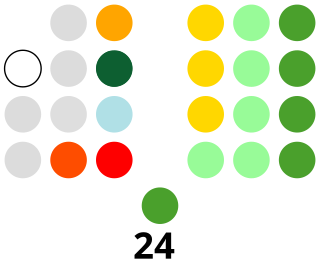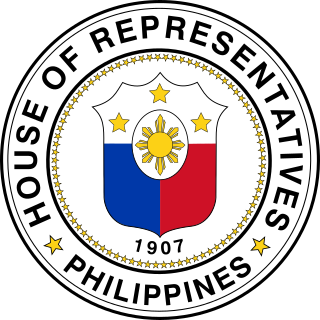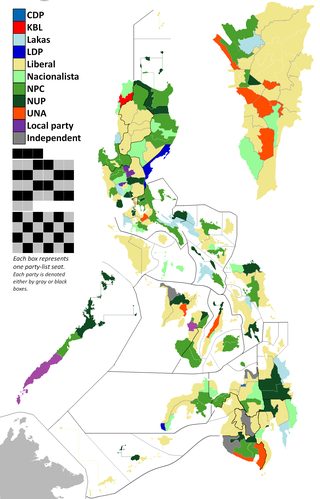
The Congress of the Philippines is the legislature of the national government of the Philippines. It is bicameral, composed of a lower body, the House of Representatives, although colloquially the term "Congress" commonly refers to just the latter, and an upper body, the Senate. The House of Representatives meets in the Batasang Pambansa in Quezon City while the Senate meets in the GSIS Building in Pasay.

The House of Representatives of the Philippines is the lower house of Congress, the bicameral legislature of the Philippines, with the Senate of the Philippines as the upper house. The lower house is usually called Congress, although the term collectively refers to both houses.

The Senate of the Philippines is the upper house of Congress, the bicameral legislature of the Philippines with the House of Representatives as the lower house. The Senate is composed of 24 senators who are elected at-large under plurality-at-large voting.
Elections in the Philippines are of several types. The president, vice-president, and the senators are elected for a six-year term, while the members of the House of Representatives, governors, vice-governors, members of the Sangguniang Panlalawigan, mayors, vice-mayors, members of the Sangguniang Panlungsod/members of the Sangguniang Bayan, barangay officials, and the members of the Sangguniang Kabataan are elected to serve for a three-year term.

Elections to the Senate of the Philippines are done via plurality-at-large voting; a voter can vote for up to twelve candidates, with the twelve candidates with the highest number of votes being elected. The 24-member Senate uses staggered elections, with only one-half of its members up for election at any given time, except for special elections, which are always held concurrently with regularly scheduled elections.

Elections for the House of Representatives of the Philippines were held on April 23, 1946. Held on the same day as the presidential election, it was held after the Nacionalista Party had split permanently into two factions: the "conservative" faction headed by president Sergio Osmeña and the "liberal" faction headed by Senate president Manuel Roxas, which later became the Liberal Party. Roxas and the Liberals won the elections, leaving the Nacionalistas with the minority in both houses of Congress.
Elections for the House of Representatives of the Philippines were held on November 8, 1949. Held on the same day as the presidential election, the party of the incumbent president, Elpidio Quirino's Liberal Party, won a majority of the seats in the House of Representatives.
Elections for the House of Representatives of the Philippines were held on November 10, 1953. Held on the same day as the presidential election, the party of the incumbent president, Elpidio Quirino's Liberal Party, won majority of the seats in the House of Representatives. However, Ramon Magsaysay of the opposition Nacionalista Party was elected president, and several elected Liberal Party congressmen defected to the Nacionalista Party, leading to José Laurel, Jr. being elected Speaker of the House of Representatives.
Elections for the House of Representatives of the Philippines were held on November 12, 1957. Held on the same day as the presidential election, the party of the incumbent president, Carlos P. Garcia's Nacionalista Party, won a majority of the seats in the House of Representatives.
Elections for the House of Representatives of the Philippines were held on November 14, 1961. Held on the same day as the presidential election, the party of the incumbent president, Carlos P. Garcia's Nacionalista Party, won majority of the seats in the House of Representatives. However, Diosdado Macapagal of the opposition Liberal Party won the presidential election, leading to majority of the elected Nacionalista congressmen to defect to the Liberal Party. This led to Cornelio Villareal being elected Speaker of the House of Representatives.
Elections for the House of Representatives of the Philippines were held on November 9, 1965. Held on the same day as the presidential election, the party of the incumbent president, Diosdado Macapagal's Liberal Party, won a majority of the seats in the House of Representatives. Despite Ferdinand Marcos of the opposition Nacionalista Party winning the presidential election, Liberal Party congressmen did not defect to the Nacionalista Party. This led to Cornelio Villareal being retained Speaker of the House after retaking it from Daniel Romualdez midway during the previous Congress.
Elections for the House of Representatives of the Philippines were held on November 11, 1969. Held on the same day as the presidential election, the party of the incumbent president, Ferdinand Marcos's Nacionalista Party, won a majority of the seats in the House of Representatives.

The 2013 Philippine House of Representatives elections were the 33rd lower house elections in the Philippines. They were held on May 13, 2013 to elect members to the House of Representatives of the Philippines that would serve in the 16th Congress of the Philippines from June 30, 2013 to June 30, 2016.
Elections for the House of Representatives in the Philippines were held on May 11, 1987. This was the first legislative election since 1984, the first House of Representatives elections since 1969, and the first election since the People Power Revolution that overthrew president Ferdinand Marcos and brought Corazon Aquino to power after alleged election fraud by the former during the 1986 presidential election against the latter.
Elections for the House of Representatives of the Philippines were held on May 11, 1992. Held on the same day as the presidential election since incumbent president Corazon Aquino did not contest the election, the Laban ng Demokratikong Pilipino (LDP) served as the de facto administration party; just as all House of Representative elections, the perceived party of the president won majority of the seats in the House of Representatives. However, Fidel V. Ramos of Lakas-NUCD won the presidential election; this caused most of the newly elected congressmen to abandon the LDP for Lakas-NUCD.
Elections for the House of Representatives of the Philippines were held on May 8, 1995. Being the first midterm election since 1938, the party of the incumbent president, Fidel V. Ramos's Lakas-NUCD-UMDP, won a plurality of the seats in the House of Representatives.
Elections for the House of Representatives of the Philippines were held on May 11, 1998. Held on the same day as the presidential election, the party of the incumbent president, Fidel V. Ramos' Lakas-NUCD-UMDP, won majority of the seats in the House of Representatives. For the first time since the People Power Revolution, a party won majority of the seats in the House; Lakas had a seat over the majority. This is also the first Philippine elections that included the party-list system.

Elections for the House of Representatives of the Philippines were held on May 10, 2004. Being held together with presidential election, the party of the incumbent president Gloria Macapagal Arroyo, Lakas-Christian Muslim Democrats, and by extension the administration-led coalition, the Koalisyon ng Katapatan at Karanasan sa Kinabukasan (K4), won majority of the seats in the House of Representatives.
Party-list representation in the House of Representatives of the Philippines refers to a system in which 20% of the House of Representatives is elected. While the House is predominantly elected by a plurality voting system, known as a first-past-the-post system, party-list representatives are elected by a type of party-list proportional representation. The 1987 Constitution of the Philippines created the party-list system. Originally, the party-list was open to underrepresented community sectors or groups, including labor, peasant, urban poor, indigenous cultural, women, youth, and other such sectors as may be defined by law. However, a 2013 Supreme Court decision clarified that the party-list is a system of proportional representation open to various kinds of groups and parties, and not an exercise exclusive to marginalized sectors. National parties or organizations and regional parties or organizations do not need to organize along sectoral lines and do not need to represent any marginalized and underrepresented sector.

The 2016 Philippine House of Representatives elections were the 34th lower house elections in the Philippines. They were held on May 9, 2016, to elect members to the House of Representatives of the Philippines. The winning candidates were to comprise the House's contingent in the 17th Congress of the Philippines that would serve from June 30, 2016, to June 30, 2019.












